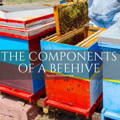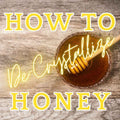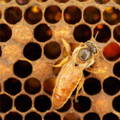
Honey Bee Queen Reproduction: A Fascinating Journey of Royal Succession
Honey bee colonies have a unique reproductive mechanism for producing a new queen bee. This process, known as supersedure or swarm-induced queen rearing, allows the hive to replace an aging or failing queen or to prepare for swarming. Here's a step-by-step explanation of how a honey beehive reproduces a new queen bee:
Subscribe
To join our mailing list and never miss an update!
FUN FACT: A colony of bees consists of 20,000-60,000 honeybees and one queen.

FUN FACT: The hexagon shapes that form honeycomb hold the most amount of honey with the smallest amount of beeswax required. Perfect efficiency.
1. Queen Recognition:
Honey bee colonies rely on a sophisticated communication system based on chemical signals called pheromones. The queen produces specific pheromones that indicate her reproductive status and overall health.
Worker bees constantly monitor these pheromone levels through their antennae. If the queen's pheromone production decreases or if she becomes unproductive, the workers recognize the need for queen replacement. This recognition triggers a series of events to rear a new queen.
2. Queen Cells Construction:
Once the workers determine the need for a new queen, they start constructing special queen cells. These cells are larger and elongated compared to regular brood cells in the hive.
They are typically built vertically at the edge or bottom of the comb, as opposed to the horizontal orientation of worker brood cells. The worker bees meticulously build these queen cells with beeswax, shaping them into a perfect cradle for the future queen.
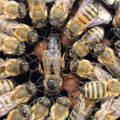
3. Royal Jelly Provisioning:
After constructing the queen cells, the worker bees select a few young larvae to develop into queens. These larvae are carefully chosen based on their age and health. The chosen larvae are fed copious amounts of royal jelly, a nutritious substance produced by the worker bees' hypopharyngeal glands.
Royal jelly is a rich source of proteins, vitamins, and hormones, making it an ideal food source for developing queens. This specialized diet triggers physiological changes in the larvae, enabling them to develop into queens rather than regular worker bees. The royal jelly stimulates the growth of reproductive organs, ovaries, and other queen-specific characteristics.
4. Cell Sealing and Pupal Development:
After a few days of being fed royal jelly, the selected larvae are sealed inside the queen cells by the worker bees. The worker bees cap the cells with beeswax to protect the developing queens during their pupal stage.
Inside the sealed cells, the larvae spin a cocoon around themselves and undergo metamorphosis. This transformative stage involves various internal changes as the larvae's organs and body structures develop into fully formed queens.
The pupal development takes approximately 8-10 days, depending on environmental conditions and the quality of nutrition received during larval stages.
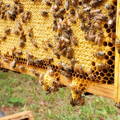
5. Virgin Queen Emergence:
After the completion of pupal development, the new queens are ready to emerge from their cells. The queens chew through the wax caps, creating an opening, and crawl out of their cells. This emergence is a critical moment in the life of a queen.
Once emerged, the first queen to come out of her cell typically kills any remaining unhatched queens in their cells. This act eliminates potential competition, ensuring her dominance as the primary queen in the colony. The worker bees in the hive accept her as the new leader.
Trending Products
6. Queen Mating:
After emerging, the newly hatched queen undergoes a maturation period within the hive. During this time, she strengthens her wing muscles, allows her exoskeleton to harden, and gains flight capabilities. Once she reaches maturity, she embarks on mating flights outside the hive.
These mating flights usually occur on warm, sunny days. The queen flies to a drone congregation area, where drones from other colonies gather. The drones release pheromones to attract the queen. When the queen encounters a drone, she mates with him in mid-air. The mating process is brief, lasting only a few seconds, during which the drone transfers sperm to the queen.
The queen mates with multiple drones to ensure genetic diversity in the colony. She stores the collected sperm in her specialized organ called the spermatheca, which will be used to fertilize eggs throughout her lifetime.
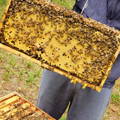
7. Colony Acceptance:
After successful mating, the newly mated queen returns to the hive. The worker bees in the colony gradually accept and recognize her as the new queen. The queen emits specific pheromones, including queen mandibular pheromone and queen footprint pheromone, which signal her presence and acceptance to the worker bees.
These pheromones help establish her authority and ensure colony cohesion. The worker bees also groom and feed the queen, further strengthening the bond and acceptance. If the queen is well-received by the workers, she assumes her role as the primary egg-layer and leader of the colony.
It's important to note that during the queen-rearing process, the new queen inherits genetic material from both the mother queen and the drones she mated with. The genetic diversity in the colony primarily comes from the drones, as the queen contributes genetically through her mother's genes. However, the queen doesn't introduce new genetic material herself during this reproductive process.
By following these intricate steps, honey bee colonies ensure the continuity of their population by replacing aging or failing queens and maintaining a healthy and productive colony. The process of queen rearing showcases the remarkable social organization and reproductive strategies of honey bees, allowing for the adaptation and survival of the hive. It is a testament to the ingenuity and efficiency of these incredible insects.
Copyright©2023 All rights reserved. We love to have you share our article as long as you include a direct link to this page. Please contact us for permission and we’ll be happy to collaborate. This article or any portion thereof , including all images, may not be reproduced or used in any manner whatsoever without the express written permission of Gypsy Shoals Farm.

